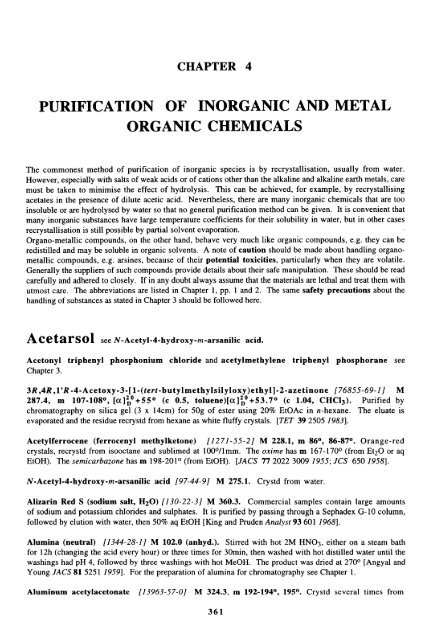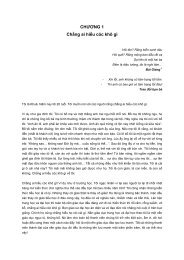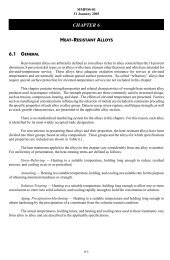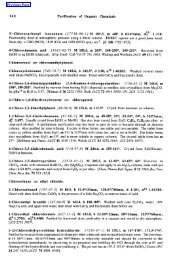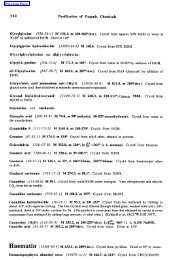purification of inorganic and metal organic ... - Nouvelle page 1
purification of inorganic and metal organic ... - Nouvelle page 1
purification of inorganic and metal organic ... - Nouvelle page 1
You also want an ePaper? Increase the reach of your titles
YUMPU automatically turns print PDFs into web optimized ePapers that Google loves.
CHAPTER 4PURIFICATION OF INORGANIC AND METALORGANIC CHEMICALSThe commonest method <strong>of</strong> <strong>purification</strong> <strong>of</strong> <strong>in<strong>organic</strong></strong> species is by recrystallisation, usually from water.However, especially with salts <strong>of</strong> weak acids or <strong>of</strong> cations other than the alkaline <strong>and</strong> alkaline earth <strong>metal</strong>s, caremust be taken to minimise the effect <strong>of</strong> hydrolysis. This can be achieved, for example, by recrystallisingacetates in the presence <strong>of</strong> dilute acetic acid. Nevertheless, there are many <strong>in<strong>organic</strong></strong> chemicals that are tooinsoluble or are hydrolysed by water so that no general <strong>purification</strong> method can be given. It is convenient thatmany <strong>in<strong>organic</strong></strong> substances have large temperature coefficients for their solubility in water, but in other casesrecrystallisation is still possible by partial solvent evaporation.Organo-<strong>metal</strong>lic compounds, on the other h<strong>and</strong>, behave very much like <strong>organic</strong> compounds, e.g. they can beredistilled <strong>and</strong> may be soluble in <strong>organic</strong> solvents. A note <strong>of</strong> caution should be made about h<strong>and</strong>ling organo<strong>metal</strong>liccompounds, e.g. arsines, because <strong>of</strong> their potential toxicities, particularly when they are volatile.Generally the suppliers <strong>of</strong> such compounds provide details about their safe manipulation. These should be readcarefully <strong>and</strong> adhered to closely. If in any doubt always assume that the materials are lethal <strong>and</strong> treat them withutmost care. The abbreviations are listed in Chapter 1, pp. 1 <strong>and</strong> 2. The same safety precautions about theh<strong>and</strong>ling <strong>of</strong> substances as stated in Chapter 3 should be followed here.Ace tar sol see N-Acetyl-4-hydroxy-rn-arsanilic acid.Acetonyl triphenyl phosphonium chloride <strong>and</strong> acetylmethylene triphenyl phosphorane seeChapter 3.3R,4R,1'R-4-Acetoxy-3-[l-(tert-butylmethylsilyloxy)ethyl]-2-azetinone [76855-69-11 M287.4, m 107-108O, [a]2,0+550 (c 0.5, tol~ene)[a]~~+53.7~ (c 1.04, CHC13). Purified bychromatography on silica gel (3 x 14cm) for 50g <strong>of</strong> ester using 20% EtOAc in n-hexane. The eluate isevaporated <strong>and</strong> the residue recrystd from hexane as white fluffy crystals. [TET 39 2505 19831.Acetylferrocene (ferrocenyl methylketone) [I 27145-21 M 228.1, m 86O, 86-87O. Orange-redcrystals, recrystd from isooctane <strong>and</strong> sublimed at 100°/lmm. The oxirne has m 167-170° (from Et2O or aqEtOH). The sernicarbazone has m 198-201O (from EtOH). [JACS 77 2022 3009 1955; JCS 650 19581.N-Acetyl-4-hydroxy-m-arsanilic acid [97-44-91 M 275.1. Crystd from water.Alizarin Red S (sodium salt, HzO) [130-22-31 M 360.3. Commercial samples contain large amounts<strong>of</strong> sodium <strong>and</strong> potassium chlorides <strong>and</strong> sulphates. It is purified by passing through a Sephadex G-10 column,followed by elution with water, then 50% aq EtOH [King <strong>and</strong> Pruden Analyst 93 601 19681.Alumina (neutral) [1344-28-11 M 102.0 (anhyd.). Stirred with hot 2M HNO3, either on a steam bathfor 12h (changing the acid every hour) or three times for 30min, then washed with hot distilled water until thewashings had pH 4, followed by three washings with hot MeOH. The product was dried at 270° [Angyal <strong>and</strong>Young JACS 81 5251 19591. For the preparation <strong>of</strong> alumina for chromatography see Chapter 1.Aluminum acetylacetonate [13963-57-01 M 324.3, m 192-194O, 195O. Crystd several times from361
362 Purification <strong>of</strong> In<strong>organic</strong> <strong>and</strong> Metal-Organic Chemicalsaqueous MeOH, hmax 216 <strong>and</strong> 286mn. [JPC 62 440 19.581. It can be purified by sublimation <strong>and</strong> has thefollowing solubilities in g per Cent: C6H6 35.9 (20°), 47.6 (40°), toluene 15.9 (20°), 22.0 (40O) <strong>and</strong>acetylacetone 6.6 (20°), 10.4 (40O). [Znorg Synth 5 105 19571.Aluminium ammonium sulphate (10H20) [7784-26-11 M 453.3, m 93O. Crystd from hot waterby cooling in ice.Aluminium bromide [7727-15-31 M 266.7, m 97O, b 114°/10mm. Refluxed <strong>and</strong> then distilled frompure aluminium chips in a stream <strong>of</strong> nitrogen into a flask containing more <strong>of</strong> the chips. It was then distd undervacuum into ampoules [Tipper <strong>and</strong> Walker JCS 1352 19591. Anhydrous conditions are essential, <strong>and</strong> the whiteto very light brown solid distillate can be broken into lumps in a dry-box (under nitrogen). Fumes in moist air.Aluminium caesium sulphate (12H20) [14284-36-71 M 568.2. Crystd from hot water (3ml/g).Aluminium chloride (anhydrous) [7446-70-01 M 133.3. Sublimed several times in an all glasssystem under nitrogen at 30-50mm pressure. Has also been sublimed in a stream <strong>of</strong> dry HCl <strong>and</strong> has beensubjected to a preliminary sublimation through a section <strong>of</strong> granular aluminium <strong>metal</strong> [for manipulative detailssee Jensen JACS 79 1226 19571. Fumes in moist air.Aluminum ethoxide [555- 75-91 M 162.2, m 154-159O, 146-151°, b 187-190°/7mm, 210-214O/13mm. Crystd from CS2 [m 139O, complex: ZPC 164 295 19331 <strong>and</strong> distd in a vacuum. Molecularweight corresponds to (AlOEt3)d. [JPC 39 1127 1935; JACS 69 2605 19471.Aluminium fluoride (anhydrous) [7784-18-41 M 84.0, m 250O. Technical material may contain upto 15% alumina, with minor impurities such as aluminium sulphate, cryolite, silica <strong>and</strong> iron oxide. Reagentgrade AlF3 (hydrated) contains only traces <strong>of</strong> impurities but its water content is very variable (may be up to40%). It can be dried by calcining at 600-80O0 in a stream <strong>of</strong> dry air (some hydrolysis occurs), followed byvacuum distn at low pressure in a graphite system, heated to approximately 925O (condenser at 900") [Henry <strong>and</strong>Dreisbach JACS 81 5274 19591.Aluminium isopropoxide p55-3I-71 M 204.3, m 119O, b 94°/0.5mm, 135°/10mm. Distdunder vacuum. Hygroscopic.Aluminium nitrate (9H20) [7784-27-21 M 375.1. Crystd from dilute HNO3, <strong>and</strong> dried by passing drynitrogen through the crystals for several hours at 40°.Aluminium potassium sulphate (12H20, alum) [7784-24-91 M 474.4, m 92O.weak aqueous H2SO4 (cu OSmVg).Crystd fromAluminium rubidium sulphate (12H20) [7784-29-41 M 496.2. Crystd from aq H2SO4 (cu 2.5mYg).Aluminium sulphate [10043-01-31 M 342.2, m 765O(dec). Crystd from hot dilute H2SO4 (1 ml/g)by cooling in ice.Aluminum trieth 1 (triethyl aluminum) [97-93-81 M 114.2, b 69O/lSmm, 76O/2.5mrn,129-131°/55mm, d? 0.695, nio 1.394. Purified by fractionation in an inert atmosphere under vacuumin a 50cm column containing a heated nichrome spiral, taking the fraction 112- 114O/27mm. It is very sensitiveto H20 <strong>and</strong> should be stored under N2. It should not contain chloride which can be shown by hydrolysis <strong>and</strong>testing with AgN03. [JACS 75 4828 51931953; NMR: JACS 81 3826 19591.Aluminium tri-tert-butoxide [556-91-21 M 246.3. Crystd from benzene <strong>and</strong> sublimed at 1 80°.Aluminium trimethanide (trimethyl aluminium) [ 75-24-11 M 72.1, m 15.2O, b11 !S0/488.2mm, 124S0/atm, dto 0.725. Distd through a 10-20 theoretical plates column under 1 atm<strong>of</strong> N2 (better with very slow take-<strong>of</strong>f). Attacks grease (use glass joints). Also vac distd over A1 in absence <strong>of</strong>
Purification <strong>of</strong> In<strong>organic</strong> <strong>and</strong> Metal-Organic Chemicals 363grease, into small glass vials <strong>and</strong> sealed under N2. Purity is measured by freezing point. Reacts with H20, isnon-conducting in C6H6 <strong>and</strong> is HIGHLY FLAMMABLE. [JCS 4681946; JACS 68 2204 19461.4-Aminophenylmercuric acetate 16283-24-51 ] M 371.8, m 168O, 17S0(dec), 180°(dec).Recrystd from hot dilute AcOH <strong>and</strong> dried in air. [JICS 32 613 1955; A 465 269 19281.Ammonia (gas) [7664-41-71 M 17.0. Major contaminants are water, oil <strong>and</strong> non-condensible gases.Most <strong>of</strong> these impurities are removed by passing the ammonia through a trap at -22O <strong>and</strong> condensing it at -176Ounder vacuum. Water is removed by distilling the ammonia into a tube containing a small lump <strong>of</strong> sodium.Also dried by passage through porous BaO, or over alumina followed by glass wool impregnated with sodium(prepared by soaking the glass wool in a solution <strong>of</strong> sodium in liquid ammonia, <strong>and</strong> evaporating <strong>of</strong>f theammonia). It can be rendered oxygen-free by passage through a soh <strong>of</strong> potassium in liquid ammonia.Ammonia (liquid) [7664-41-71 M 17.0, m -77.7O, b -33.4O, d 0.597. Dried, <strong>and</strong> stored, withsodium in a steel cylinder, then distd <strong>and</strong> condensed by means <strong>of</strong> liquid air, the non-condensable gases beingpumped <strong>of</strong>f. In order to obtain liquid NH3 from a cylinder turn the cylinder up-side-down (i.e. with the valve atthe bottom, use a <strong>metal</strong> st<strong>and</strong> to secure it in this position) <strong>and</strong> lead a plastic tube from the tap to a measuringcylinder placed in an efficient fume cupboard which is kept running. Turn the tap on <strong>and</strong> allow the ammonia tobe released. At first, gas <strong>and</strong> liquid will splatter out (make sure that the plastic tube is secure) but soon theliquid will drip into the measuring cylinder. The high latent heat <strong>of</strong> evaporation will cool the ammonia so thatthe liquid will remain cool <strong>and</strong> not boil vigorously. If the ammonia is required dry the necessary precautionsshould be taken, i.e. the gas is allowed to flow through tubes packed with coarse CaO pellets.Ammonia (aqueous) [7664-41-71 M 17.0 + H20, d 0.90 (satd, 27% w/v, 14.3 N). Obtained<strong>metal</strong>-free by saturating distilled water, in a cooling bath, with ammonia (from tank) gas. Alternatively, canuse isothermal distn by placing a dish <strong>of</strong> conc aq ammonia <strong>and</strong> a dish <strong>of</strong> pure water in an empty desiccator <strong>and</strong>leaving for several days. AMMONIA (gas, liquid or aq soh) is very irritating <strong>and</strong> should notbe inhaled as it can lead to olfactory paralysis (temporary <strong>and</strong> partially permanent).Ammonium acetate [631-61-81 M 77.1, m 112-114O. Crystd twice from anhydrous acetic acid, driedunder vacuum for 24h at 100° [Roll <strong>and</strong> Sutcliff TFS 57 1078 19611.Ammonium bisulphate [7803-63-61 M 115.1O. Crystd from water at room temperature (lml/g) byadding EtOH <strong>and</strong> cooling.Ammonium bromide 11 21 24-97-91 M 98.0, m 450°(sublimes). Crystd from 95% EtOH.Ammonium chloride [12125-02-91 M 53.5. Crystd several times from conductivity water (1.5ml/g)between 90° <strong>and</strong> Oo. Sublimes.Ammonium chromate [7788-98-91 M 152.1. Crystd from weak aqueous ammonia (ca 2.5ml/g) bycooling from room temperature.Ammonium dichromate [7788-09-51 M 252.1, m 170°(dec). Crystd from weak aq HCI (ca lml/g).Ammonium dihydrogen arsenate [13462-93-61 M 159.0. Crystd from water (lml/g).Ammonium dihydrogen orthophosphate [7722-76-11 M 115.0, m 190O.(0.7mUg) between 100° <strong>and</strong> Oo.Crystd from waterAmmonium ferric oxalate (3H20) 113268-42-31 M 428.1. Crystd from hot water (OSml/g).Ammonium ferric sulphate (12H20) [7783-83-71 M 482.2. Crystd from aqueous ethanol.Ammonium ferrous sulphate (6H2O) [7783-85-91 M 392.1. A soh in warm water (1.5ml/g) wascooled rapidly to Oo, <strong>and</strong> the resulting fine crystals were filtered at the pump, washed with cold distilled water<strong>and</strong> pressed between sheets <strong>of</strong> filter paper to dry.
364 Purification <strong>of</strong> In<strong>organic</strong> <strong>and</strong> Metal-Organic ChemicalsAmmonium fluorosilicate [16919-19-01 M 178.1. Crystd from water (2mVg).Ammonium formate [540-69-21 M 63.1, m 116O, 117.3O, d4,' 1.280. Heat solid in NH3 vapour<strong>and</strong> dry in vacuum till N H3 dour is faint. Recryst from abs EtOH <strong>and</strong> then keep in a desiccator over 99%H2SO4 in vucuo. It is very hygroscopic. Exists in two forms, stable needles <strong>and</strong> less stable plates. Als<strong>of</strong>orms acid salts, i.e. HC02NH4.3HC02H <strong>and</strong> HC02NH4.HC02H. [JACS 43 1473 1921; 63 3124 1941 1.Ammonium hexachloroiridate (IV) [1694-92-41 M 641.0. Ppted several times from aqueous soh bysaturation with ammonium chloride. This removes any palladium <strong>and</strong> rhodium. Then washed with ice-coldwater <strong>and</strong> dried over conc H2SO4 in a vacuum desiccator. If osmium or ruthenium is present, it can be removedas the tetroxide by heating with conc HNO3, followed by conc HC104, until most <strong>of</strong> the acid has been driven<strong>of</strong>f. (This treatment is repeated). The near-dry residue is dissolved in a small amount <strong>of</strong> water <strong>and</strong> added toexcess NaHCO3 soh <strong>and</strong> bromine water. On boiling, iridic (but not platinic) hydroxide is ppted. It is dissolvedin HCI <strong>and</strong> ppted several times, then dissolved in HBr <strong>and</strong> treated with HNO3 <strong>and</strong> HCl to convert the bromidesto chlorides. Saturation with ammonium chloride <strong>and</strong> cooling precipitates ammonium hexachloroiridate whichis filtered <strong>of</strong>f <strong>and</strong> purified as above [Woo <strong>and</strong> Yost JACS 53 884 19311.Ammonium hexacyan<strong>of</strong>errate I1 hydrate [I4481 -29-91 M 284.1. The pale yellow trihydrate powdercan be washed with 10% aq NH3, filtd, then washed several times with EtOH <strong>and</strong> Et20, <strong>and</strong> dried at room temp.Decomposes in vacuum above looo <strong>and</strong> should be stored away from light <strong>and</strong> under N2. In light <strong>and</strong> air itdecomposes by losing NH3. [H<strong>and</strong>book <strong>of</strong>Preparative In<strong>organic</strong> Chem, (ed Bruuer) Vol II 1509 19651.Ammonium hexafluorophosphate [16741-11-01 M 163.0, dig 2.181. Crystallises from H20 insquare plates. Decomposes on heating before melting. Soluble in H20 at 20° (74.8% w/v), also very solublein Me2C0, MeOH, EtOH <strong>and</strong> MeOAc <strong>and</strong> is decomposed by boiling acids. [B 63 1063 19301.Ammonium hypophosphite [ 7803-65-81 M 117.1. Crystd from hot EtOH.Ammonium iodate [13446-09-81 M 192.9. Crystd from water (8mVg) between looo <strong>and</strong> Oo.Ammonium iodide [12027-06-41 M 144.9. Crystd from EtOH by addition <strong>of</strong> ethyl iodide. Veryhygroscopic. Stored in the dark.Ammonium ionophore I (Nonactin) [6833-86-71 M 736.9, m 147-148O, [or]; Oo (c 1.2,CHCIJ). Crystd from MeOH in colourless needles <strong>and</strong> is dried at 20° in high vac. A selectophore with highsensitivity for NH: ions. [HCA 38 1445 1955,45 129 1962,55 1371 1972; Acta Cryst 27B 1680 19711.Ammonium magnesium chloride (6HzO) [60314-43-41 M 256.8. Crystd from water (6ml/g) bypartial evapn in a desiccator over KOH.Ammonium magnesium sulphate (6H2O) [20861-69-21 M 360.6.between 1oOO <strong>and</strong> 00.Crystd from water (Iml/g)Ammonium manganous sulphate (6HzO) [13566-22-81 M 391.3. Crystd from water (2ml/g) bypartial evapn in a desiccator.Ammonium metavanadate(2omVg).Ammonium molybdate [I3desiccator.[7803-55-61 M 117.0, m 200°(dec). Crystd from conductivity water06-76-81 M 196.0. Crystd from water (2.5ml/g) by partial evapn in aAmmonium nickel sulphatebetween 90° <strong>and</strong> Oo.(6H20) [15699-18-01 M 395.0. Crystd from water (3ml/g)
Purification <strong>of</strong> In<strong>organic</strong> <strong>and</strong> Metal-Organic Chemicals 365Ammonium nitrate [6484-52-21 M 80.0. Crystd twice from distilled water (1mYg) by adding EtOH, orfrom warm water (OSmVg) by cooling in an ice-salt bath. Dried in air, then under vacuum.Ammonium oxalate (HzO) [6009-70-71 M 142.1. Crystd from water (10mYg) between 50° <strong>and</strong> Oo.Ammonium perchlorate [7790-98-91 M 117.5. Crystd twice from distilled water (2.5mYg) between80° <strong>and</strong> Oo, <strong>and</strong> dried in a vacuum desiccator over P2O5. Drying at 1 loo might lead to slow decomposition tochloride. POTENTIALLY EXPLOSIVE.Ammonium reineckate [13573-16-51 M 345.5, m 270-273O(dec). Crystd from water, between 30°<strong>and</strong> Oo, working by artificial light. Solns <strong>of</strong> reineckate decompose slowly at room temperature in the dark <strong>and</strong>more rapidly at higher temperatures or in diffuse sunlight.Ammonium selenate [7783-21-31 M 179.0. Crystd from water at room temperature by adding EtOH <strong>and</strong>cooling.Ammonium sulphamate [7773-06-01 M 114.1, m 132-135O. Crystd from water at room temperature(lml/g) by adding EtOH <strong>and</strong> cooling.Ammonium sulphate [7783-20-21 M 132.1, m 230°(dec). Crystd twice from hot water containing0.2% EDTA to remove <strong>metal</strong> ions, then finally from distilled water. Dried in a desiccator for two weeks overMg(C104)2.Ammonium tetrafluoroborate [ 13826-53-01 M 104.8. Crystd from conductivity water (lml/g)between 1 OOO <strong>and</strong> Oo.Ammonium tetraphenylborate [I 4637-34-41 M 337.3, m ca 220°(dec). Dissolve in aqueousMe2CO <strong>and</strong> allow crystn to proceed slowly otherwise very small crystals are formed. No trace <strong>of</strong> Me2CO wasleft after drying at 120° [TFS 53 19 19571. The salt was ppted from dilute AcOH soh <strong>of</strong> sodiumtetraphenylborane in the presence <strong>of</strong> NHiions. After st<strong>and</strong>ing for Smin, the ppte was filtered <strong>of</strong>f onto a sinteredporcelain crucible, washed with very dilute AcOH <strong>and</strong> dried at room temp for at least 24h [AC 28 1001 19561.Alternatively a soln <strong>of</strong> sodium tetraphenylborane (5% excess) in H20 is added to NH&l soln. After Smin theppte is collected, washed several times with H20 <strong>and</strong> recryst from aqueous Me2CO. [ACA 19 342 19581.Ammonium thiocyanate [1762-95-41 M 76.1, m 138O(dec). Crystd three times from dilute HC104,to give material optically transparent at wavelengths longer than 270nm. Has also been crystd from absoluteMeOH <strong>and</strong> from acetonitrile.Ammonium tungstate [I 1120-25-51 M 283.9. Crystd from warm water by adding EtOH <strong>and</strong> cooling.Ammonium (meta) vanadate [7803-55-61 M 117.0, d: 2.326. Wash with H20 until free from C1-<strong>and</strong> dry in air. It is soluble in H20 (5.18g/100 at 15O, 10.4g/100 at 32O) but is more soluble in dilute NH3.When heated at relatively low temperatures it loses H20 <strong>and</strong> NH3 to give vanadium oxide (V2O5) <strong>and</strong> at 210° itforms lower oxides. [Inorg Synth 3 117 19501.n-Amylmercuric chloride [544-15-01 M 307.2, m 110O. Crystd from EtOH.9,10-Anthraquinone-2,6-disulphonic acid (disodium salt) [84-50-41 M 412.3, m >325O.Crystd three times from water, in the dark [Moore et al. JCSFTI 82 745 19861.9,10-Anthraquinone-2-sulphonic acid (sodium salt, H20) [131-08-8] M 328.3. Crystd fromwater using active charcoal.Antimony (V) pentafluoride [7783-70-21 M 216.7, m 7.0°, 8.3O, b 141°, 150°, 148-150°, d2.99. Purified by vacuum distillation preferably in a quartz apparatus, <strong>and</strong> stored in quartz or aluminum
366 Purification <strong>of</strong> In<strong>organic</strong> <strong>and</strong> Metal-Organic Chemicalsbottles. It is a hygroscopic viscous liquid which reacts violently with H20 <strong>and</strong> is hydrolysed by alkalis. It isPOISONOUS <strong>and</strong> attacks the skin. [JCS 2200 1950; H<strong>and</strong>book <strong>of</strong> Preparative In<strong>organic</strong> Chemistry (edBruuer) Vol I 200 1964.Antimony trichloride [10025-91-9/ M 228.1, m 73O, b 283O. Dried over P2O5 or by mixing withtoluene or xylene <strong>and</strong> distilling (water is carried <strong>of</strong>f with the <strong>organic</strong> solvent), then distd twice under dry nitrogenat 50mm, degassed <strong>and</strong> sublimed twice in a vacuum into ampoules. Can be crystd from CS2. Deliquescent.Fumes in moist air.Antimony trifluoride [7783-56-41 M 178.8, m 292O. Crystd from MeOH to remove oxide <strong>and</strong>oxyfluoride, then sublimed under vacuum in an aluminium cup on to a water-cooled copper condenser [WoolfJCS 279 19551.Antimony triiodide [7790-44-51 M 502.5, m 167O. Sublimed under vacuum.Antimony trioxide [1309-64-41 M 291.5, m 656O. Dissolved in minimum volume <strong>of</strong> dilute HCl,filtered, <strong>and</strong> six volumes <strong>of</strong> water were added to ppte a basic antimonous chloride (free from Fe <strong>and</strong> SbO5). Theppte was redissolved in dilute HCI, <strong>and</strong> added slowly, with stirring, to a boiling soh (containing a slightexcess) <strong>of</strong> Na2C03. The oxide was filtered <strong>of</strong>f, washed with hot water, then boiled <strong>and</strong> filtered, the processbeing repeated until the filtrate gave no test for chloride ions. The product was dried in a vacuum desiccator[Schuhmann JACS 46 52 19241.Argon [7440-37-11 M 39.95, b -185.6O. Rendered oxygen-free by passage over reduced copper at 450°,or by bubbling through alkaline pyrogallol <strong>and</strong> H2SO4, then dried with CaS04, Mg(C104)2, or Linde 5Amolecular sieves. Other <strong>purification</strong> steps include passage through Ascarite (asbestos impregnated with sodiumhydroxide), through finely divided uranium at about 80O0 <strong>and</strong> through a -78O cold trap.Alternatively the gas is passed over CuO pellets at 300O to remove hydrogen <strong>and</strong> hydrocarbons, over Ca chips at600O to remove oxygen <strong>and</strong>, finally, over titanium chips at 700O to remove nitrogen. Also purified by freezepump-thawcycles <strong>and</strong> by passage over sputtered sodium [Arnold <strong>and</strong> Smith JCSFT2 77 861 19811.o-Arsanilic acid [2045-00-31 M 216.1, m 153O,p-Arsanilic acid (98-50-01 M 216.1, m 232O. Crystd from water or ethanol/ether.Arsenazo I [520-10-5] M 614.3, E 2.6 x lo4 at SOOnm, pH 8.0. A saturated aqueous soln <strong>of</strong> the freeacid was slowly added to an equal volume <strong>of</strong> conc HCl. The orange ppte was filtered, washed with acetonitrile<strong>and</strong> dried for 1-2h at 1100 [Fritz <strong>and</strong> Bradford AC 30 1021 19581.Arsenazo I11 [1667-00-41 M 776.4. Contaminants include monoazo derivatives, starting materials forsynthesis <strong>and</strong> by-products. Partially purified by pptn <strong>of</strong> the dye from aqueous alkali by addition <strong>of</strong> HCl. Morethorough <strong>purification</strong> by taking a 2g sample in 15-25m1 <strong>of</strong> 5% aq NH3 <strong>and</strong> filter. Add lOml HCl (1 : 1) to thefiltrate to ppte the dye. Repeat procedure <strong>and</strong> dissolve solid dye (0.5g) in 7ml <strong>of</strong> a 1:l:l mixture <strong>of</strong> n-propano1:conc NH3:water at 50°. After cooling, filter soln <strong>and</strong> treat the filtrate on a cellulose column using3:l:l mixture <strong>of</strong> n-propano1:conc NH3:water as eluent. Collect the blue b<strong>and</strong> <strong>and</strong> evaporate to 10-15ml below80°, then add lOml conc HCI to ppte pure Arsenazo 111. Wash with EtOH <strong>and</strong> air-dry [Borak et al. Taluntu 17215 19701. The purity <strong>of</strong> the dye can be checked by paper chromatography using M HCl as eluent.Arsenic [7440-38-21 M 74.9, m 816O. Heated under vacuum at 350° to sublime oxides, then sealed in aPyrex tube under vacuum <strong>and</strong> sublimed at 600O, the arsenic condensing in the cooler parts <strong>of</strong> the tube. Storedunder vacuum [Shih <strong>and</strong> Peretti JACS 75 608 19.531.Arsenic tribromide [82868-10-8/ M 394.6, m 89°/11mm, 221°/760mm. Distd under vacuum.Arsenic trichloride [60646-36-81 M 181.3, b 130.0O. Refluxed with arsenic for 4h, then fractionallydistd. The middle fraction was stored with sodium wire for two days, then again distd [Lewis <strong>and</strong> Sowerby JCS336 19571. Next Page


